Maliszewski and “The Books That Founded D&D”
Saturday, November 21, 2009
posted by Deuce Richardson
 Print This Post
Print This Post

James Maliszewski, the proprietor of Grognardia and a Friend of The Cimmerian, has posted an article on The Escapist website. It is called “The Books That Founded D&D” and I found it quite interesting. I thought it worth some commentary.
Mr. Maliszewski starts his essay noting the various reasons why J.R.R. Tolkien should be dismissed as major influence upon the role-playing game that Gygax and Arneson developed. Most of the evidence used to back this up is cited from Gygax’s own writings. The fact that these writings date from before and after the threatened lawsuit by Tolkien Enterprises means very little, in my view.
Tolkien deeply influenced Dungeons and Dragons. That is my humble opinion and I stand by it. The Elves as portrayed in D&D would be far different if JRRT had never written his novel, The Lord of the Rings. The same for D&D dwarves. Double ditto for “orcs,” which species (with that particular appellation) would never exist, but for Tollers. Triple ditto for the “halflings” in the game (whom I always considered ridiculous, in game terms). All of that, however, is fodder for another blog entry. Now, let’s get to all the stuff that James Maliszkewski and I do agree on (more or less)…
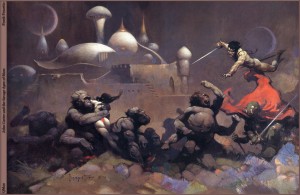
Edgar Rice Burroughs gets name-checked. Right on. The man was foundational to American “speculative fiction” in all its forms. Howard had more ERB volumes in his library than those of any other author. H.P. Lovecraft devoured Burroughs’ fiction as a youth. Ray Bradbury has never been shy about the influence of the Man From Tarzana upon his writings, nor was Leigh Brackett reticent about same. While Michael Moorcock has sometimes tried to distance himself from ERB fan beginnings, the evidence is there for all to see. Gygax would’ve had to work very hard to exclude the presence of ERB from his game. About all he would have been left with was Poe, Baum and Cabell for the Americans, and Haggard, Morris, Hodgson, Eddison and JRRT for the Brits .
Maliszewski then cites Robert E. Howard. Now, to me, it’s hard to find much concrete evidence of REH in the game as it was presented ’round about 1980, despite what Gygax had to say about Howard’s influence. There were no true serpent-men in the first Monster Manual. Nor do I recall any sort of close analogues to Worms of the Earth/Children of the Night/People of the Dark. Magic runs absolutely rampant within D&D, in direct opposition to Howard’s fantasy yarns. Most game modules seemed based on the premise that civilization was the optimum condition and that barbarians needed to be pacified. Perhaps I am not recalling the right scenarios.
Pratt and De Camp’s ‘Harold Shea’ tales are then discussed. I think we are on a little firmer ground at this point. The two authors usually attempted to put a “modern” spin on whatever milieu Mr. Shea and his friends dumped themselves into. Such a tone often seemed to be taken with the many modules I’m familiar with. I always felt myself wishing that Gygax had borrowed more from Sprague’s tales of Pusâd (if he was going to borrow from LSdC at all).
Fritz Leiber is next on the agenda. I have little to add regarding Mr. Maliszewski’s assessments. Personally, I believe that Leiber’s tales matched the 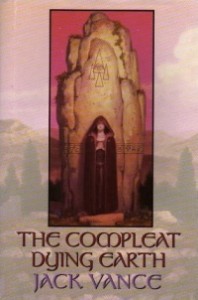 feel of early D&D as well or better than those of any other author discussed in the article.
feel of early D&D as well or better than those of any other author discussed in the article.
Mr. Malizsewski then takes a look at the ‘Dying Earth’ stories by Jack Vance. He’ll find no argument from me regarding their influence upon old-school D&D. The magic system thereof (which I never thought worked that well, in game terms) is indisputably based upon that created by Vance. “Ioun stones,” anyone?
H.P. Lovecraft is given his due. Besides the ilithids and kuo-toa that Maliszewski cites, I would also posit that all the various puddings, slimes and oozes (not to mention the gibbering mouthers) found in the game are variations on a shoggothian theme.
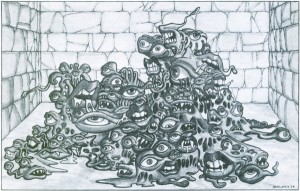
Abraham (“A.”) Merritt gets looked at rather quickly by Mr. Maliszewski, in my opinion. What he does say focuses primarily on Merritt novels such as The Moon Pool and The Face in the Abyss. From where I stand, it appears  that books like The Ship of Ishtar and The Dwellers in the Mirage were far more likely influences on Gygax. The latter two novels by Merritt are both just a hair’s breadth away from outright Sword-and-Sorcery. Perhaps Maliszewski concentrated on Merritt’s other works because he recently blogged about The Ship of Ishtar. It’s just good to see someone giving a shout-out to ol’ Abe. Merritt’s influence on fantasy (and thus D&D) is wide-spread, though little aknowledged today, so kudos to JM for the mention.
that books like The Ship of Ishtar and The Dwellers in the Mirage were far more likely influences on Gygax. The latter two novels by Merritt are both just a hair’s breadth away from outright Sword-and-Sorcery. Perhaps Maliszewski concentrated on Merritt’s other works because he recently blogged about The Ship of Ishtar. It’s just good to see someone giving a shout-out to ol’ Abe. Merritt’s influence on fantasy (and thus D&D) is wide-spread, though little aknowledged today, so kudos to JM for the mention.
Malizsewski notes the influence of Poul Anderson’s fantasies upon Dungeons and Dragons, most especially, Three Hearts and Three Lions. This cannot be denied. The hero of Three Hearts and Three Lions, Holger Carlsen, is indubitably the model for D&D’s paladin class. The regenerating, carrot-nosed trolls seen in D&D were definitely five-finger-discounted by TSR from Anderson. Personally, I always wished that Gygax had used Poul’s classic novel, The Broken Sword, as a primary inspiration. The trolls in that book are infinitely more interesting than the riddling, squirmy-haired buffoon one encounters in Three Hearts and Three Lions.
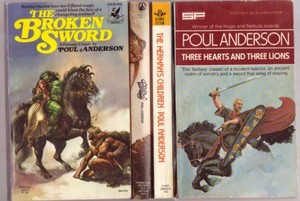
Michael Moorcock is discussed briefly. Maliszewski points out that Moorcock’s Law/Order Mythos (ultimately derived from Anderson) was appropriated (with a few tweaks) for the D&D alignment system.
Maliszewski closes by writing this:
It’s unfortunate that so many of these books and authors today are largely unknown except to aficionados of early fantasy and science fiction. It’s my hope that, by bringing these authors to wider public knowledge, more people might not only recognize the debt that the hobby of roleplaying owes to their remarkable imaginations but also enjoy their writings in their own right. Like D&D itself, whose influence extends far beyond tabletop roleplaying games, these writers and their ideas contributed much to contemporary popular culture and they deserve their due.
While I may not agree with every one of Mr. Maliszewski’s conclusions, I can wholeheartedly get behind that sentiment. Right on, sword-brother.
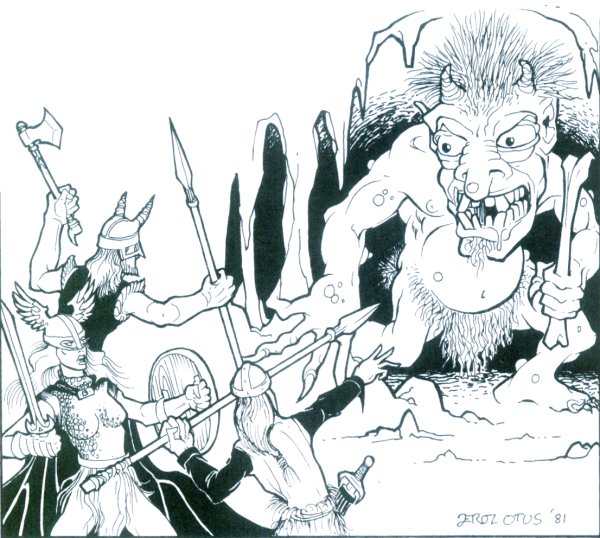
*Art by Frazetta and Otus.
